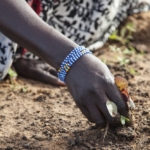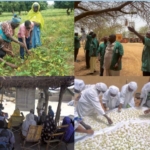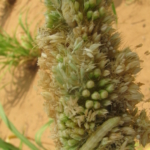


Universite de Maradi
International Crops Research Institute for the Semi-Arid Tropics, Institut de l'Environnement et de Recherches Agricoles, l'Institut d'Economie Rurale
Burkina Faso Niger Mali
8/2014—8/2018
The millet head miner (also known as millet head work or MHW) is one of its most important pests of pearl millet, a key crop in Sahelian west Africa. The MHW became a major pest in the West African Sahel during the droughts of 1972–1974, and has since remained a threat to food security of smallholder farmers in the region. The “GIMEM” project, which has been funded through CCRP since 2001, has been very successful in its research on biological control of MHW through the use of one of the pest’s natural enemies. The proposed project builds on the previous two phases of GIMEM. The overall objective of this project is to reduce losses due to the MHW and to enhance pearl millet yields via development of a parasitoid industry for controlling the MHW in the Sahel. The project will start with studies related to analysis of MHW incidence and identification of areas with recurrent MHW infestations. These will then be the starting point for development of local biological control industry. Meetings will be initiated for selecting, training and launching of private and community-based marketing units of the parasitoids. Delivery of parasitoid for MHW bio-control will be supported locally in each country with an annual coverage of at least 500,000 hectares of pearl millet and a reduction in losses of MHW by 40%.Biological control methods against the MHW will be enhanced with the use of egg parasitoids in order to increase early pest mortality. An inventory of natural egg parasitoids of the MHW, mass rearing and on-farm testing of species considered successful will be done in the three countries. Additional data on the biology and dynamics of larvae and adults of MHW will be collected each year of the project to better understand the factors influencing the pest infestations. This information will contribute to establish warning and preventive system for MHW control.Varietal resistance for MHW will be studied through on-farm evaluation of new genotypes of pearl millet developed by teams of pearl millet breeders in the three countries. Information will be shared with producers groups and organizations through participatory assessments and field open days. The project will involve 3 PhD and 6 MSc students, all the students will be enrolled in local universities. Monitoring and evaluation of the project will be done through annual meetings between countries, exchange visits and workshops organized by the regional project team.
Identify and implement private or community based structures for production and sale of parasitoid H. hebetor in rural areas.Make the control methods of MHW more effectiveDevelop an early warning of MHW outbreakIdentify and promote the use of millet varieties resistant or tolerant to MHWIncrease the capacity building of national research team on IPM techniques in the three countriesMonitor and evaluate the project impact
The project will target resource-poor pearl millet farmers facing frequent outbreaks of the MHW in Burkina Faso, Mali, and Niger. It aims at disseminating technologies for sustainable MHW control, and promises to cover at least 500,000 ha of millet production area per country/year including at least 3,000,000 households, with a 40% reduction in yield losses due to MHW. At least six private enterprises/community-based initiatives producing parasitoids for sale will be established. In each country, technologies for early detection of the MHW occurrence and the biological control program will be disseminated through training of at least 100 extension agents, 500 farmers and managers of parasitoid production units. NARS capacity will be strengthened through support for three PhD and six MSc studentships. The project also aims to train six scientists from countries not involved (i.e. Chad, Nigeria, Senegal, Soudan) for dissemination of the technologies. For a large dissemination of project results at least five peer reviewed papers, three technical documents and five training materials will be published.




